"City of waterfalls"
Ranchi Tourism
Once identified as the summer capital of Bihar, Ranchi was also known to be a hill station during the British rule owing to its altitude of 2140 feet, umpteen waterfalls plummeting from pretty hills and the ever so pretty winding rivulets. The city is now the state capital of mineral-rich state Jharkhand and takes immense pride in accounting for the 40 percent of the country?s total mineral reserves. Other than this, the city is bestowed with emerald green forests adding to the natural serenity, tranquillity and nature?s bliss.
Located at a height of 1, 140 feet above sea level, Ranchi is also the capital ofJharkhand. With the tourism of this city slowly catching pace, Ranchi will soon be considered as one of the important destinations in India. Ranchi has beautiful waterfalls and hills that make this place the most favored holiday destination in Jharkhand. The most popular places in this city include Ranchi Hill, Kanke Dam,Tagore hillandHudru falls, Hatia Museum and Tribal Research Institute and Museum. The city has a very rich variety of trees and wildlife, Maugha, Sal and Simul are some of the rare varieties of trees found here.
Download Ranchi PDF Guide >
What's Great?
Beautiful landscape.
What's not so Great?
Poor waste management, poor drainage systems, traffic.
For Whom
Ranchi, being the capital of Jharkhand is perfect for a visit by people from other cities in Jharkhand and nearby cities in Orissa and West Bengal. Ranchi is an ideal choice for weekend trips.
History of Ranchi
The district of Ranchi, located in the Chota Nagpur plateau, was initially inhabited by the Munda and Oraon races. The region was free of any external forces until the accession of Mughal king Akbar in 1585. The region was exploited for its resources for a long time under the Mughal rule until it came under the British Raj in 1765. The Maharaja of Ramgarh was appointed to look after the administration of the city. The change of rule, however, was unaccepted by the localities and so the British formed a new region (including Ranchi and the neighbouring towns) called the South- Western Frontier Agency. This fell under the direct rule of the Governor General of India. The district played a significant role during the Indian struggle for independence and was a strategic centre point for many movements. After independence, Ranchi was included in the Bihar state. But after the creation of Jharkhand in 2000, Ranchi became a part of the new state and was officially declared its capital.
Culture of Ranchi
Ranchi has a vibrant culture which is a confluence of different tribes (old and new) and their traditional practices. The culture is influenced by ancient native tribals, Buddhist, the Hindu kings and the Mughals. People mostly practise agriculture or work in the mines due to the nature of the region. Rice and Wheat are the staple foods of Ranchi.
The town is also known for various folk music, arts and dance forms such as Chhau and Santhal (named after the Santhal tribe). Chatth Puja is the most popular festival followed by Holi, Diwali, Basant Panchmi etc.
You can also find tastefully done handiwork and beautiful wood carvings here. Local labour make use of bamboo and wood from the forests to make wicker baskets, rice huskers, mats, coasters etc. Pottery and Painting are another specialities of the region. Scroll Paintings or Paitkar painting is a popular form and is done by the tribals. Sohrai Art is another painting form depicting bulls, horned deities, nature etc., done by women during festivals or harvest time.
The city of waterfalls
Situated on the Deccan plateau, Ranchi is a picturesque city that offers a rejuvenating view of hills, small rock formations and numerous waterfalls which give the city its nickname. A rising industrial hub, Ranchi exhibits a blend of various cultures and communities which are prevalent in their cuisine and festivals itself. The city is also known to inspire several works of Rabindranath Tagore evidence of which are still preserved in the Tagore Hills.
Land of the Mundas
Previously known as the 'forest land', Ranchi is home to several tribes, mainly the Santhals and the Mundas. As a result, unique forms of music, art and cuisine can be found in this region. The tribal Pitkar paintings, wood and bamboo works found in this region attracts a lot of tourists to Ranchi.
Itinerary
Day 1:Arrive in Ranchi and visit the Dassam Falls and Jonha Falls, the latter of which is a type of hanging valley falls. In the evening join the devotees in the Jagannath Temple and witness the beautiful panoramic site of the city from the high perched top deck. Appreciate the fine Kalinga style architecture and don?t forget to take back some of the Ayurvedic medicines outside the temple.
Day 2:Wake up early the next morning and set off to visit the famous Pahari Temple built on top of a hill lock. This is also the place where the freedom fighters were hanged to death. A bird?s eye view of the entire city is possible and this can be reached by taking a flight of around 300 steps. Proceed to the Rock garden post lunch and spend some quiet time with nature. In the evening, visit the mesmerizing Hundru Falls.
Day 3:You can dedicate the last day to visit the Birsa zoological park and the Tagore Hill, preferably at the time of sunset.
Restaurants and Local Food in Ranchi
Ranchi provide a modest variety in its restaurants and local street food outlests and Dhabas. You can choose from local Jharkhand cuisine, a typical Indian menu and popular items of Chinese cuisine. One must indulge in the popular desserts as well as theChaatfound here.Other than this one might try popular items of the state, such asPua, Litti, Handia, Kanda, Aloo Chokha, Dubhni Rotiand more.
View 5 Restaurants in Ranchi >>
Jul-Maris the best time to visit Ranchi
Ranchi has sub-tropical climate i.e, extremely hot in summers and cool in winters. Though Ranchi can be visited anytime during the year, the number of tourists drop in May-June due to the extreme heat in the region.
Weather in Ranchi
Loading...
Ranchi in Summer (March-June)
Summer temperature in Ranchi ranges between 16 °C - 36 °C. The hot and humid climate attracts fewer tourists during this season leading to a drop in hotel prices.
Ranchi in Monsoon (July - September)
Monsoons bring moderate rainfall in the region. Rains bring down the temperature of Ranchi and make the weather comfortable for outing and sightseeing.
Ranchi in Winter (November-February)
Though winter mornings in Ranchi are pleasant and ideal for sight seeing, the town receives chilly nights with dense fogs. However, this is the best season to explore Ranchi.
Monthly Weather in Ranchi
Month
Avg. Minimum (°C)
Avg. Maximum (°C)
January
11
25
February
14
28
March
17
32
April
24
38
May
25
38
June
25
36
July
24
30
August
24
30
September
24
30
October
20
30
November
14
28
December
11
26
Comments on Ranchi
Post Your Comment


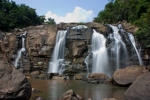 Panch Gagh Falls
Panch Gagh Falls Ranchi Lake
Ranchi Lake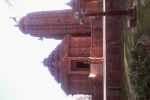 Sun temple
Sun temple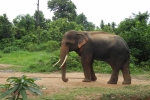 Birsa Zoological Park
Birsa Zoological Park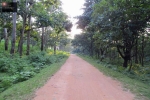 Hazaribagh
Hazaribagh Bodh Gaya
Bodh Gaya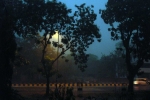 Jamshedpur
Jamshedpur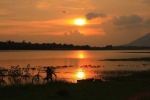 Purulia
Purulia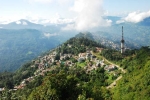 Gangtok
Gangtok Darjeeling
Darjeeling